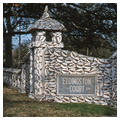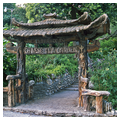Mexican artisan Dionicio Rodríguez (1891–1955) is known as the most “naturalistic” exponent of the technique known as faux bois false wood or trabajo rústico rustic work of the 1920s–1940s. Faux bois had its beginnings in 1849 with the invention of reinforced concrete by Joseph Monier, a French gardener. He created concrete plant containers reinforced with wire and the genre soon spread throughout Europe, the Middle East, Japan, and Central and South America.
Rodríguez was born in Toluca, Mexico, in 1891, and it is believed that he learned the technique from two concrete contractors, Luis Robles Gil and J. W. Douglas, in Mexico City, where he worked on the fountain and rocks at Lagos de Chapúltepec and other projects.
His ability to sculpt forms and textures in nature was unsurpassed. He created amazingly realistic shapes and surfaces mimicking different species of wood with knotholes, insect borings, split and peeling bark, and lichen, as well as rough and smooth rock. Imitations of metal hardware, pyramid-headed bolts, and countersunk screws appear throughout his work.
The artisan was assisted by helpers who constructed forms of steel or copper rebar for his sculptures. These reinforcing rods were wired together, wrapped with metal lath sometimes infilled with rubble for large pieces, and covered with rough and scratch coats of concrete. Rodríguez then sat down with a bag of pure Portland cement, and began to create the texture with handmade tools, kitchen cutlery, combs, and brushes. The final procedure was the application of color. Rodríguez zealously guarded the identity of his chemicals by mixing them in an enclosed tent or the trunk of his car which he would quickly shut if anyone became curious and by breaking the jars when finished to keep their contents secret.
He arrived in San Antonio in 1924, where the largest concentration of his work in Texas is found. His first client was exiled Mexican physician Aureliano Urrutia, who was familiar with Rodríguez's Mexico City work. Urrutia's garden, Miraflores 800 Hildebrand St., the site of nine of the artisan's sculptures, was one of five planned landscape environments in Texas that included fences, gates, bridges, grottoes, fountains, “hollow tree” shelters, tables, “fallen tree” benches, and steps. Many of Rodríguez's “wood” structures were capped with roofs made of “bundled straw” known as palapas in Mexico. Variations of Rodríguez's designs, created without plans or preliminary drawings, were repeated throughout his career and some project designs were dictated by his clients. Like Dr. Urrutia, many of Rodríguez's clients were wealthy, and his jobs came from word-of-mouth referrals. Much of his work was done during the Great Depression: his labor was cheap and the raw materials were inexpensive.
Fifteen of Rodríguez's sculptures in Texas are listed on the National Register of Historic Places. Not extant is his own tree house in San Antonio, where he lived between travels to his numerous commissions.
In the early 1930s, Rodríguez began to receive commissions for work in seven additional states, including Pugh's Old Mill in North Little Rock, Memorial Park Cemetery in Memphis, and cemeteries in other states that were developed during the period when flat bronze markers were replacing upright tombstones. Cemetery owners decorated these memorial parks with sculpture, and his work contributed to this need for funerary art. The enormous scope of his endeavors is evidenced by travels to projects in Arkansas, Alabama, Illinois, Michigan, New Mexico, and Washington, D.C.
For his travels around the country Rodríguez was prosperous enough to purchase a new car each year, and members of his family and friends often accompanied him to help with jobs. Occasionally he would hire local laborers. After Rodríguez's death in 1955, numerous fellow artisans, including Máximo Cortés, Sam Murray, and George Briones continued to produce faux bois work. Third-generation family member and great-nephew Carlos Cortés carries on the family tradition and examples of his designs are found throughout San Antonio.
Writing Credits
If SAH Archipedia has been useful to you, please consider supporting it.
SAH Archipedia tells the story of the United States through its buildings, landscapes, and cities. This freely available resource empowers the public with authoritative knowledge that deepens their understanding and appreciation of the built environment. But the Society of Architectural Historians, which created SAH Archipedia with University of Virginia Press, needs your support to maintain the high-caliber research, writing, photography, cartography, editing, design, and programming that make SAH Archipedia a trusted online resource available to all who value the history of place, heritage tourism, and learning.





